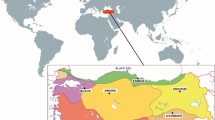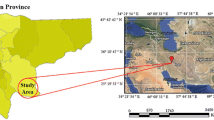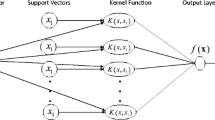Abstract
This study aims to design an early warning system based on machine learning for short-term prediction of nocturnal frosts in Kurdistan Province in the west of Iran. Four models of artificial neural network (ANN), support vector machine (SVM), adaptive neuro-fuzzy inference system (ANFIS), and multiple linear regression were used to achieve this main goal. Hourly data of six variables of dry-bulb temperature, wet-bulb temperature, cloud cover, relative humidity, and wind speed and direction were selected as the inputs of these four models at 18:30 local time, and according to them, nocturnal temperatures were predicted for 21:30, 00:30, 03:30, and 06:30 local time. Comparing the outputs of these four models with observational data, all models predicted nocturnal temperatures both in the early hours (21:30 and 00:30 local time) and in the late hours of the night (03:30 and 06:30 local time) the same or less than the observational temperatures. Considering the different performance criteria of the models, such as mean absolute errors (MAE), mean squares errors (MSE), and root-mean-squares errors (RMSE), ANN with Posline transfer function, and Trainlm training function, has less error and better performance in predicting nocturnal temperatures compared to other models. When the main goal is predicting the temperature extremes, especially frost, it is concluded that ANN did not perform very well compared to other models. In addition, ANFIS and SVM models have a better performance in this area than other models. Finally, an early warning system for nocturnal frost was designed for Kurdistan Province in the west of Iran using these four models, and its ability was tested to make short-term nocturnal frost predictions. The results show that this system is suitable for the short-term prediction of nocturnal frosts.








Similar content being viewed by others
Availability of data and materials
Some or all data, models, or code that supports the findings of this study are available from the corresponding author upon reasonable request.
References
Abdel-Aal RE (2004) Hourly temperature forecasting using abductive networks. Eng Appl Artif Intell 17(5):543–556. https://doi.org/10.1016/j.engappai.2004.04.002
Abdel-Aal RE, Elhadidy MA (1994) A machine-learning approach to modelling and forecasting the minimum temperature at Dhahran. Saudi Arabia Energy 19(7):739–749. https://doi.org/10.1016/0360-5442(94)90012-4
Alijani B, Mahmoudi P, Rigi Chahi AB, Khosravi P (2010) Investigation of the persistence of frost days in Iran using chain Markov model. Phys Geogr Res Q 42(73):1–19 (In Persian)
Alizamir M, Kisi O, Adnan RM, Kuriqi A (2020) Modelling reference evapotranspiration by combining neuro-fuzzy and evolutionary strategies. Acta Geophys 68:1113–1126. https://doi.org/10.1007/s11600-020-00446-9
Anfossi D, Bacci P, Longhetto A (1976) Forecasting of vertical temperature profiles in the atmosphere during nocturnal radiation inversions from air temperature trend at screen height. Q J R Meteorol Soc 102(431):173–180. https://doi.org/10.1002/qj.49710243114
Asefa T, Kemblowski M, McKee M, Khalil A (2006) Multi-time scale stream flow predictions: the support vector machines approach. J Hydrol 318(1–4):7–16. https://doi.org/10.1016/j.jhydrol.2005.06.001
Asefa T, Kemblowski MW, Urroz G, McKee M, Khalil A (2004) Support vectors–based groundwater head observation networks design. Water Resources Res. https://doi.org/10.1029/2004WR003304
Astsatryan H, Grigoryan H, Poghosyan A, Abrahamyan R, Asmaryan S, Muradyan V, Tepanosyan G, Guigoz Y, Giuliani G (2021) Air temperature forecasting using artificial neural network for Ararat valley. Earth Sci Inf 14(2):711–722. https://doi.org/10.1007/s12145-021-00583-9
Avissar R, Mahrer Y (1988). Mapping frost-sensitive areas with a three-dimensional local-scale numerical model. Part I. Physical and numerical aspects. J Appl Meteorol Climatol 27(4), 400–413. https://doi.org/10.1175/1520-0450(1988)027<0400:MFSAWA>2.0.CO;2
Avissar R, Mahrer Y (1988) Mapping frost-sensitive areas with a three-dimensional local-scale numerical model. Part II: comparison with observations. J Appl Meteorol (1988–2005), 27(4), 414–426. https://doi.org/10.1175/1520-0450(1988)027<0414:MFSAWA>2.0.CO;2
Azad A, Farzin S, Kashi H, Sanikhani H, Karami H, Kisi O (2018) Prediction of river flow using hybrid neuro-fuzzy models. Arab J Geosci 11(22):1–14. https://doi.org/10.1007/s12517-018-4079-0
Bagdonas A, Schwartz L (1978) Techniques of frost prediction and methods of frost and cold protection. Technical Note No. 157, WMO
Behzad M, Asghari K, Coppola EA Jr (2010) Comparative study of SVMs and ANNs in aquifer water level prediction. J Comput Civ Eng 24(5):408–413. https://doi.org/10.1061/(ASCE)CP.1943-5487.0000043
Bilgili M, Sahin B (2009) Prediction of long-term monthly temperature and rainfall in Turkey. Energy Sources, Part A Recov Util Environ Eff 32(1):60–71. https://doi.org/10.1080/15567030802467522
Blanc ML, Geslin H, Holzberg IA, Mason B (1963) Protection against frost damage. WMO Techn. Note No. 51
Boser BE, Guyon IM, Vapnik VN (1992) A training algorithm for optimal margin classifiers. In: Proceedings of the fifth annual workshop on computational learning theory (pp 144–152). https://doi.org/10.1145/130385.130401
Brunt D (1941) Physical and dynamical meteorology, 2nd edn. Cambridge University Press, New York
Bruton JM, McClendon RW, Hoogenboom G (2000) Estimating daily pan evaporation with artificial neural networks. Trans ASAE 43(2):491. https://doi.org/10.13031/2013.2730
Bukhari AH, Sulaiman M, Islam S, Shoaib M, Kumam P, Raja MAZ (2020) Neuro-fuzzy modeling and prediction of summer precipitation with application to different meteorological stations. Alex Eng J 59(1):101–116. https://doi.org/10.1016/j.aej.2019.12.011
Cellier P (1993) An operational model for predicting minimum temperatures near the soil surface under clear sky conditions. J Appl Meteorol Climatol 32(5):871–883. https://doi.org/10.1175/1520-0450(1993)032%3C0871:AOMFPM%3E2.0.CO;2
Chattopadhyay S, Jhajharia D, Chattopadhyay G (2011) Univariate modelling of monthly maximum temperature time series over northeast India: neural network versus Yule-Walker equation based approach. Meteorol Appl 18(1):70–82. https://doi.org/10.1002/met.211
Cornford CE (1938) Katabatic winds and the prevention of frost damage. Q J R Meteorol Soc 64(277):553–592. https://doi.org/10.1002/qj.49706427702
Cristianini N, Shawe-Taylor J (2000) An introduction to support vector machines and other kernel-based learning methods. Cambridge University Press, New York
Dibike YB, Velickov S, Solomatine D, Abbott MB (2001) Model induction with support vector machines: introduction and applications. J Comput Civ Eng 15(3):208–216. https://doi.org/10.1061/(ASCE)0887-3801(2001)15:3(208)
Eccel E, Ghielmi L, Granitto P, Barbiero R, Grazzini F, Cesari D (2007) Prediction of minimum temperatures in an alpine region by linear and non-linear post-processing of meteorological models. Nonlinear Processes Geophys, 14(3), pp.211–222. https://npg.copernicus.org/articles/14/211/2007/
Elizondo D, Hoogenboom G, McClendon RW (1994) Development of a neural network model to predict daily solar radiation. Agric Meteorol 71(1–2):115–132. https://doi.org/10.1016/0168-1923(94)90103-1
Ellison ES (1928) A critique on the construction and use of minimum-temperature formulas. Mon Weather Rev 56(12):485–495. https://doi.org/10.1175/1520-0493(1928)56%3C485:ACOTCA%3E2.0.CO;2
Figuerola PI, Mazzeo NA (1997) An analytical model for the prediction of nocturnal and dawn surface temperatures under calm, clear sky conditions. Agric Meteorol 85(3–4):229–237. https://doi.org/10.1016/S0168-1923(96)02398-2
Francl LJ, Panigrahi S (1997) Artificial neural network models of wheat leaf wetness. Agric Meteorol 88(1–4):57–65. https://doi.org/10.1016/S0168-1923(97)00051-8
Geiger R, Aron RH, Todhunter P (1995) The climate near the ground. Harvard University Press, Cambridge
Ghielmi L, Eccel E (2006) Descriptive models and artificial neural networks for spring frost prediction in an agricultural mountain area. Comput Electron Agric 54(2):101–114. https://doi.org/10.1016/j.compag.2006.09.001
Giardina J, Digonzelli P, Romero, E., & Duarte, D. (2013). Frost severity effect on sprouting and seedling emergence of high quality seed cane in Tucuman, Argentina. In: Proc Int Soc Sugar Cane Technol, vol 28, pp 1–11.
Graupe D (2007) Principles of artificial neural networks. World Scientific Publishing Co., Hackensack
Groen P (1947) Note on the theory of nocturnal radiational cooling of the earth’s surface. J Atmos Sci 4(2):63–66. https://doi.org/10.1175/1520-0469(1947)004%3C0063:NOTTON%3E2.0.CO;2
Hamel LH (2011) Knowledge discovery with support vector machines. Wiley, Hoboken, Vol 3
Han H, Felker P (1997) Estimation of daily soil water evaporation using an artificial neural network. J Arid Environ 37(2):251–260. https://doi.org/10.1006/jare.1997.0269
Hayati M, Mohebi Z (2007) Application of artificial neural networks for temperature forecasting. World Acad Sci Eng Technol 28(2):275–279. https://doi.org/10.5281/zenodo.1070987
Hernandez G, Müller GV, Villacampa Y, Navarro-Gonzalez FJ, Aragonés L (2020) Predictive models of minimum temperatures for the south of Buenos Aires province. Sci Total Environ 699:134280. https://doi.org/10.1016/j.scitotenv.2019.134280
Hessami Kermani M, Valiparast Farkhani R (2020) Evaluation of wavelet regression and neuro-fuzzy models for estimating urban water consumption (case study: Kerman City). Iran Water Res J, 14(3)
Howell GW, Johnson DE, Mansfield TK (1981) Factors influencing spring freeze damage to developing grape shoots. Proc Mich Grap Soc 2:1–22
Jaeger JC (1945) Note on the effect of wind on nocturnal cooling. Q J R Meteorol Soc 71(309–310):388–390. https://doi.org/10.1002/qj.49707130916
Jain, A. (2003). Frost prediction using artificial neural networks: A temperature prediction approach. M. S. Thesis, Artificial Intelligence Centre, University of Georgia, Athens, GA
Jallal MA, Chabaa S, El Yassini A, Zeroual A, Ibnyaich S (2019) Air temperature forecasting using artificial neural networks with delayed exogenous input. In: 2019 international conference on wireless technologies, embedded and intelligent systems (wits). IEEE, pp 1–6. https://doi.org/10.1109/WITS.2019.8723699
Jang JS (1993) ANFIS: adaptive-network-based fuzzy inference system. IEEE Trans Syst Man Cybern 23(3):665–685. https://doi.org/10.1109/21.256541
Jeong C, Shin JY, Kim T, Heo JH (2012) Monthly precipitation forecasting with a neuro-fuzzy model. Water Resour Manage 26(15):4467–4483. https://doi.org/10.1007/s11269-012-0157-3
Kalma JD, Laughlin GP, Caprio JM, Hamer PJC (1992) The bioclimatology of frost. Springer-Verlag, London, p 144
Kassomenos P, Flocas HA, Lykoudis S, Petrakis M (1997) A study of frost events in areas characterised by the absence of observations. Meteorol Atmos Phys 62(3):249–256. https://doi.org/10.1007/BF01029706
Kaur A, Singh H (2011) Artificial neural network in forecasting minimum temperature. Int J Electron Commun Technol 2(3):101–105
Khan MS, Coulibaly P (2006) Application of support vector machine in lake water level prediction. J Hydrol Eng 11(3):199–205. https://doi.org/10.1061/(ASCE)1084-0699(2006)11:3(199)
Klöppel M, Stilke G, Wamser C (1978) Experimental investigations into variations of ground-based inversions and comparisons with results of simple boundary-layer models. Bound-Layer Meteorol 15(2):135–145. https://doi.org/10.1007/BF00121917
Lee S, Lee YS, Son Y (2020) Forecasting daily temperatures with different time interval data using deep neural networks. Appl Sci 10(5):1609. https://doi.org/10.3390/app10051609
Liong SY, Sivapragasam C (2002) Flood stage forecasting with support vector machines 1. JAWRA J Am Water Resources Assoc 38(1):173–186. https://doi.org/10.1111/j.1752-1688.2002.tb01544.x
Litta AJ, Mary Idicula S, Mohanty UC (2013) Artificial neural network model in prediction of meteorological parameters during premonsoon thunderstorms. Int J Atmos Sci. https://doi.org/10.1155/2013/525383
Liu X, Zhang C, Liu P, Yan M, Wang B, Zhang J, Higgs R (2018) Application of temperature prediction based on neural network in intrusion detection of IoT. Secur Commun Netw. https://doi.org/10.1155/2018/1635081
Mahmoudi P (2014) Mapping statistical characteristics of frosts in Iran. Int Arch Photogramm Remote Sens Spatial Inform Sci 40(2):175–180. https://doi.org/10.5194/isprsarchives-XL-2-W3-175-2014
Maity R (2018) Regression analysis and curve fitting. In: statistical methods in hydrology and hydroclimatology. Springer, Singapore, pp 229–257. https://doi.org/10.1007/978-981-10-8779-0_7
Mamdani EH (1974) Application of fuzzy algorithms for control of simple dynamic plant. In: Proceedings of the institution of electrical engineers. IET, vol 121, no 12, pp 1585–1588. https://doi.org/10.1049/piee.1974.0328
Memarian H, Bilondi MP, Rezaei M (2016) Drought prediction using co-active neuro-fuzzy inference system, validation, and uncertainty analysis (case study: Birjand, Iran). Theoret Appl Climatol 125(3):541–554. https://doi.org/10.1007/s00704-015-1532-9
Mohandes M, Rehman S, Rahman SM (2011) Estimation of wind speed profile using adaptive neuro-fuzzy inference system (ANFIS). Appl Energy 88(11):4024–4032. https://doi.org/10.1016/j.apenergy.2011.04.015
Mosavi A, Edalatifar M (2018) A hybrid neuro-fuzzy algorithm for prediction of reference evapotranspiration. In: International conference on global research and education. Springer, Cham, pp 235–243. https://doi.org/10.1007/978-3-319-99834-3_31
Najafi A, Azizi GS, Mokhtari MH (2017) Assessment kernel support vector machines in classification of landuses. Basin of Cheshmeh kileh-Chalkrod, Case Study
Nezhad EF, Ghalhari GF, Bayatani F (2019) Forecasting maximum seasonal temperature using artificial neural networks “Tehran case study.” Asia-Pac J Atmos Sci 55(2):145–153. https://doi.org/10.1007/s13143-018-0051-x
Prabha T, Hoogenboom G (2008) Evaluation of the weather research and forecasting model for two frost events. Comput Electron Agric 64(2):234–247. https://doi.org/10.1016/j.compag.2008.05.019
Reuter H (1951) Forecasting minimum temperatures. Tellus 3(3):141–147. https://doi.org/10.1111/j.2153-3490.1951.tb00791.x
Robinson C, Mort N (1997) A neural network system for the protection of citrus crops from frost damage. Comput Electron Agric 16(3):177–187. https://doi.org/10.1016/S0168-1699(96)00037-3
Rogers WJ, Swift HL (1970) Frost and the prevention of frost damage. Frost Prev Frost Damage
Rossi F, Facini O, Loreti S, Nardino M, Georgiadis T, Zinoni F (2002) Meteorological and micrometeorological applications to frost monitoring in northern Italy orchards. Phys Chem Earth, Parts a/b/c 27(23–24):1077–1089. https://doi.org/10.1016/S1474-7065(02)00144-4
Roy DS (2020) Forecasting the air temperature at a weather station using deep neural networks. Procedia Comput Sci 178:38–46. https://doi.org/10.1016/j.procs.2020.11.005
Salcedo-Sanz S, Deo RC, Carro-Calvo L, Saavedra-Moreno B (2016) Monthly prediction of air temperature in Australia and New Zealand with machine learning algorithms. Theoret Appl Climatol 125(1):13–25. https://doi.org/10.1007/s00704-015-1480-4
Schultz A, Wieland R, Baumann A (1995) The use of neural networks in agroecological modelling. IFAC Proc Volumes 28(4):55–60. https://doi.org/10.1016/S1474-6670(17)45540-6
Snyder RL, Melo-Abreu JD (2005) Frost protection: fundamentals, practice and economics. Volume 1. Frost Prot Fundam Pract Econ 1:1–240
Sugeno M (1985) An introductory survey of fuzzy control. Inf Sci 36(1–2):59–83. https://doi.org/10.1016/0020-0255(85)90026-X
Sugeno M, Nishida M (1985) Fuzzy control of model car. Fuzzy Sets Syst 16(2):103–113
Sundaram M, Prakash M, Surenther I, Balaji NV, Kannimuthu S (2020) Weather forecasting using machine learning techniques. Test Eng Manag 2020(83):15264–15273
Sutherland RA (1980) A short-range objective nocturnal temperature forecasting model. J Appl Meteorol Climatol 19(3):247–255. https://doi.org/10.1175/1520-0450(1980)019%3C0247:ASRONT%3E2.0.CO;2
Tran TTK, Bateni SM, Ki SJ, Vosoughifar H (2021) A review of neural networks for air temperature forecasting. Water 13(9):1294. https://doi.org/10.3390/w13091294
Tsukamoto T (1979) An approach to fuzzy reasoning method. In: Gupta MM, Ragade RK, Yager RR (eds) Advances in fuzzy set theory and applications. North-Holland, Amsterdam, pp 137–149
Turrell FM (1973) The science and technology of frost protection, Chap. 10. Citrus Industry III, Div Agric Sei University of California, Berkeley, pp 383–446.
Ustaoglu B, Cigizoglu HK, Karaca M (2008) Forecast of daily mean, maximum and minimum temperature time series by three artificial neural network methods. Meteorol Appl A J Forecast Pract Appl, TrainTechn Model 15(4):431–445. https://doi.org/10.1002/met.83
Vapnik V (1998) Statistical learning theory. Wiley, Hoboken
Yang CC, Prasher SO, Mehuys GR, Patni NK (1997) Application of artificial neural networks for simulation of soil temperature. Trans ASAE 40(3):649–656. https://doi.org/10.13031/2013.21324
Young FD (1920) Forecasting minimum temperatures in Oregon and California. Mon Wea Rev 16:53–60
Yu X, Liong SY (2007) Forecasting of hydrologic time series with ridge regression in feature space. J Hydrol 332(3–4):290–302. https://doi.org/10.1016/j.jhydrol.2006.07.003
Yu PS, Chen ST, Chang IF (2006) Support vector regression for real-time flood stage forecasting. J Hydrol 328(3–4):704–716. https://doi.org/10.1016/j.jhydrol.2006.01.021
Zhang Z, Dong Y (2020) Temperature forecasting via convolutional recurrent neural networks based on time-series data. Complexity. https://doi.org/10.1155/2020/3536572
Acknowledgements
This article's authors are required to thank the Meteorological Organization of Iran for providing hourly data on various meteorological variables for stations in Kurdistan Province.
Author information
Authors and Affiliations
Contributions
EM helped in methodology, validation, formal analysis, investigation, resources, visualization, validation, writing—review and editing. PM was involved in conceptualization, methodology, formal analysis, investigation, writing—original draft, writing—review and editing, resources, data curation, supervision. YKT contributed to software, writing—review and editing. TT supervised the study. SMAJ helped in methodology, writing—review and editing.
Corresponding author
Ethics declarations
Conflict of interest
The authors declare that they have no known competing financial interests or personal relationships that could have appeared to influence the work reported in this paper.
Additional information
Edited by Prof. Ewa Bednorz (ASSOCIATE EDITOR) / Prof. Theodore Karacostas (CO-EDITOR-IN-CHIEF).
Supplementary Information
Below is the link to the electronic supplementary material.
Rights and permissions
Springer Nature or its licensor (e.g. a society or other partner) holds exclusive rights to this article under a publishing agreement with the author(s) or other rightsholder(s); author self-archiving of the accepted manuscript version of this article is solely governed by the terms of such publishing agreement and applicable law.
About this article
Cite this article
Mesgari, E., Mahmoudi, P., Kord Tamandani, Y. et al. A comparative assessment of the ability of different types of machine learning in short-term predictions of nocturnal frosts. Acta Geophys. (2024). https://doi.org/10.1007/s11600-023-01276-1
Received:
Accepted:
Published:
DOI: https://doi.org/10.1007/s11600-023-01276-1




